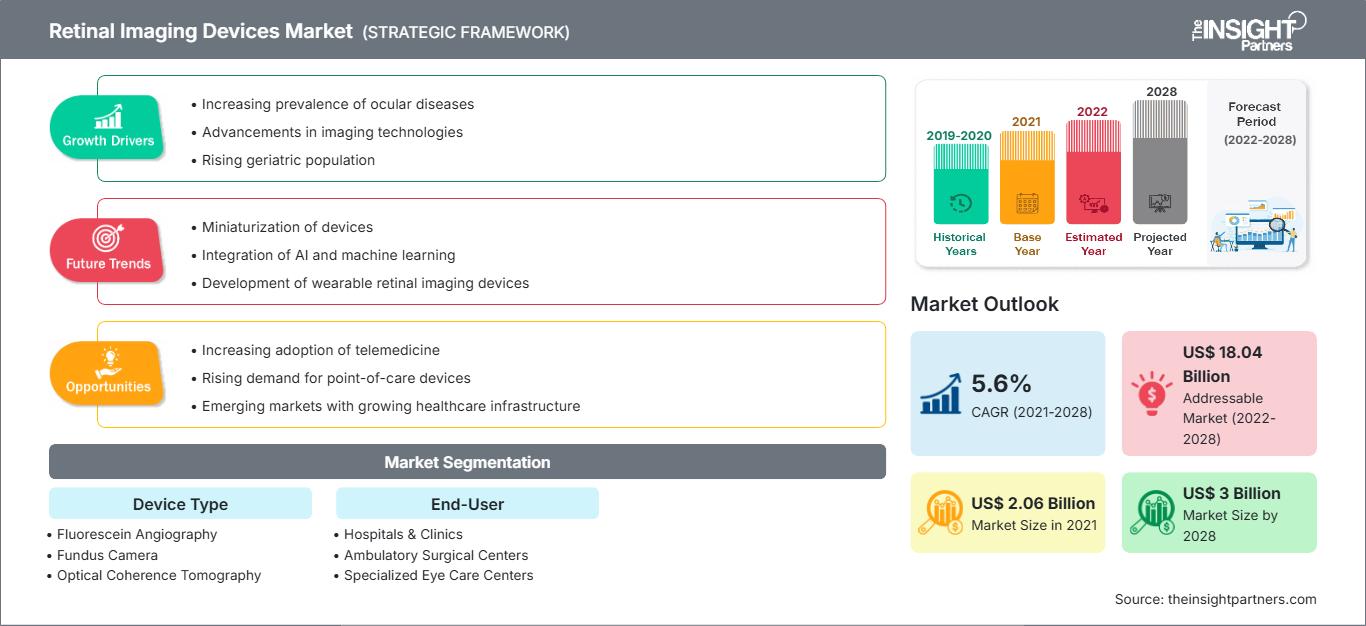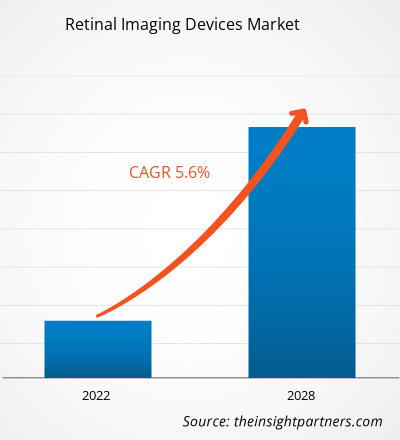Der Markt für Netzhautbildgebungsgeräte soll von 2,06 Milliarden US-Dollar im Jahr 2021 auf 3,00 Milliarden US-Dollar im Jahr 2028 anwachsen; das Wachstum wird zwischen 2021 und 2028 auf durchschnittlich 5,6 % geschätzt.
Die Netzhautbildgebung ist eine Technik zur Analyse und Diagnose des Zustands der Netzhaut eines Patienten. Netzhautbildgebungsgeräte (RID) verwenden hochauflösende Bildgebungssysteme, um Bilder des Augeninneren aufzunehmen. Das aufgenommene Bild hilft Ärzten im Virtual Private Network (VSP), den Zustand der Netzhaut zu beurteilen, was wiederum zur Erkennung und Behandlung von Augen- und Gesundheitserkrankungen wie Diabetes, Glaukom und Makuladegeneration beiträgt.
Passen Sie diesen Bericht Ihren Anforderungen an
Sie erhalten kostenlos Anpassungen an jedem Bericht, einschließlich Teilen dieses Berichts oder einer Analyse auf Länderebene, eines Excel-Datenpakets sowie tolle Angebote und Rabatte für Start-ups und Universitäten.
Markt für Netzhautbildgebungsgeräte: Strategische Einblicke

-
Holen Sie sich die wichtigsten Markttrends aus diesem Bericht.Dieses KOSTENLOSE Beispiel umfasst Datenanalysen, die von Markttrends bis hin zu Schätzungen und Prognosen reichen.
Das Wachstum des Marktes für Netzhautbildgebungsgeräte ist auf den verbesserten Zugang von Augenärzten zur Netzhaut, wachsende globale Initiativen zur Behandlung von Blindheit und technologische Fortschritte zurückzuführen. Die hohen Kosten von OCT-Geräten hemmen jedoch das Marktwachstum.
Markteinblicke: Steigende Prävalenz von Augenkrankheiten
Netzhautbildgebungsgeräte werden häufig zur Diagnose und Behandlung verschiedener Augenkrankheiten wie diabetischer Retinopathie, altersbedingter Makuladegeneration, Glaukom, okulärem Melanom und leichten Sehproblemen eingesetzt. Darüber hinaus nimmt die Sorge um Blindheit oder Sehbehinderung weltweit erheblich zu. Laut den im Oktober 2021 von der Weltgesundheitsorganisation (WHO) veröffentlichten Daten leben fast 2,2 Milliarden Menschen mit einer Sehbehinderung oder Blindheit. Davon könnten etwa eine Milliarde Fälle von Sehbehinderung durch die richtige Diagnose und Behandlung verhindert werden. Diese eine Milliarde Menschen leiden an verschiedenen Augenproblemen, die mit mittelschwerer oder schwerer Sehbehinderung oder Blindheit in der Ferne zusammenhängen. Bildbasierte Diagnosetechnologien ermöglichen bei der Behandlung von Augenkrankheiten auf der Grundlage morphologischer Datensätze ein beispielloses Wachstum. Ein solcher Faktor dürfte dem Markt für Geräte zur Netzhautbildgebung im Prognosezeitraum zugutekommen.
Gerätetypbasierte Erkenntnisse
Basierend auf dem Gerätetyp wurde der globale Markt für Geräte zur Netzhautbildgebung in Fluoreszenzangiographie, Funduskamera und optische Kohärenztomographie segmentiert. Das Segment der Funduskameras hatte 2021 den größten Marktanteil. Die Fundusfotografie hat sich von elektronischen Blitzen über Smartphone-basierte Kameras zu einem neueren tragbaren Augenuntersuchungsset (PEEK) gewandelt. PEEK ist eine Smartphone-basierte Anwendung für eine umfassende Augenuntersuchung. Der Vorteil dieser Kameras besteht darin, dass auch Nicht-Augenärzte Bilder aufnehmen und diese mit etwas Übung auch bewerten können. Es wird jedoch erwartet, dass das Segment der optischen Kohärenztomographie im Prognosezeitraum die höchste durchschnittliche jährliche Wachstumsrate (CAGR) von 8,1 % verzeichnen wird. Die optische Kohärenztomographie ermöglicht die Beurteilung verschiedener Grade der Makulaischämie, die in der primären Bildgebung nicht diagnostiziert werden. Die Technik wird als Standard für Bildgebungsverfahren für Augen verwendet.
Endbenutzerbasierte Erkenntnisse
Basierend auf dem Endbenutzer ist der globale Markt für Netzhautbildgebungsgeräte in Krankenhäuser und Kliniken, Fachkliniken, ambulante Versorgungszentren und andere segmentiert. Das Segment Krankenhäuser und Kliniken hatte 2021 den größten Marktanteil, und spezialisierte Augenkliniken werden im Prognosezeitraum voraussichtlich die höchste durchschnittliche jährliche Wachstumsrate (CAGR) von 6,6 % verzeichnen.
Markt für Netzhautbildgebungsgeräte
Die Analysten von The Insight Partners haben die regionalen Trends und Faktoren, die den Markt für Netzhautbildgebungsgeräte im Prognosezeitraum beeinflussen, ausführlich erläutert. In diesem Abschnitt werden auch die Marktsegmente und die geografische Lage in Nordamerika, Europa, im asiatisch-pazifischen Raum, im Nahen Osten und Afrika sowie in Süd- und Mittelamerika erörtert.Umfang des Marktberichts zu Geräten zur Netzhautbildgebung
| Berichtsattribut | Einzelheiten |
|---|---|
| Marktgröße in 2021 | US$ 2.06 Billion |
| Marktgröße nach 2028 | US$ 3 Billion |
| Globale CAGR (2021 - 2028) | 5.6% |
| Historische Daten | 2019-2020 |
| Prognosezeitraum | 2022-2028 |
| Abgedeckte Segmente |
By Gerätetyp
|
| Abgedeckte Regionen und Länder |
Nordamerika
|
| Marktführer und wichtige Unternehmensprofile |
|
Dichte der Marktteilnehmer für Netzhautbildgebungsgeräte: Auswirkungen auf die Geschäftsdynamik verstehen
Der Markt für Netzhautbildgebungsgeräte wächst rasant. Die steigende Nachfrage der Endnutzer ist auf Faktoren wie veränderte Verbraucherpräferenzen, technologische Fortschritte und ein stärkeres Bewusstsein für die Produktvorteile zurückzuführen. Mit der steigenden Nachfrage erweitern Unternehmen ihr Angebot, entwickeln Innovationen, um den Bedürfnissen der Verbraucher gerecht zu werden, und nutzen neue Trends, was das Marktwachstum weiter ankurbelt.
- Holen Sie sich die Markt für Netzhautbildgebungsgeräte Übersicht der wichtigsten Akteure
Regionale Einblicke
Nach Regionen betrachtet hatte Nordamerika im Jahr 2021 den größten Anteil und dürfte im Prognosezeitraum einen ähnlichen Trend aufweisen. Die Region Asien-Pazifik wird im Prognosezeitraum voraussichtlich die höchste Wachstumsrate verzeichnen. Der Einsatz von künstlicher Intelligenz (KI) und Deep-Learning-Systemen (DLS) zur Verbesserung der Screening-Abdeckung in Singapur dürfte das regionale Wachstum in den nächsten sieben Jahren unterstützen.
Produkteinführungen und -zulassungen sind gängige Strategien von Unternehmen, um ihre globale Präsenz und ihr Produktportfolio zu erweitern. Darüber hinaus konzentrieren sich die Akteure auf dem Markt für Netzhautbildgebungsgeräte auf Partnerschaftsstrategien, um ihren Kundenstamm zu erweitern und so ihren Markennamen weltweit zu behaupten.
Basierend auf dem Gerätetyp wird der Markt für Netzhautbildgebungsgeräte in Fluoreszenzangiographie, Funduskamera und optische Kohärenztomographie unterteilt. Basierend auf dem Endverbraucher ist der Markt in Krankenhäuser und Kliniken, ambulante Operationszentren, spezialisierte Augenkliniken und andere Endverbraucher segmentiert. Geografisch ist der Markt für Netzhautbildgebungsgeräte in Nordamerika (USA, Kanada und Mexiko), Europa (Großbritannien, Deutschland, Frankreich, Italien, Spanien und das übrige Europa), den Asien-Pazifik-Raum (China, Japan, Indien, Australien, Südkorea und den übrigen Asien-Pazifik-Raum), den Nahen Osten und Afrika (die Vereinigten Arabischen Emirate, Saudi-Arabien, Südafrika und den übrigen Nahen Osten und Afrika) sowie Süd- und Mittelamerika (Brasilien, Argentinien und den übrigen Süd- und Mittelamerika) segmentiert.
Einige der in unserem Forschungsumfang aufgeführten Unternehmensprofile sind unter anderem Carl Zeiss Meditec, Revenio Group Oyj, Nikon Corporation, Optomed, Topcon Corporation, Imagine Eyes, Epipole Ltd, Forus Health Pvt Ltd, Eyenuk Inc und Phoenix Technology Group LLC.- Historische Analyse (2 Jahre), Basisjahr, Prognose (7 Jahre) mit CAGR
- PEST- und SWOT-Analyse
- Marktgröße Wert/Volumen – Global, Regional, Land
- Branchen- und Wettbewerbslandschaft
- Excel-Datensatz
Aktuelle Berichte
Erfahrungsberichte
Grund zum Kauf
- Fundierte Entscheidungsfindung
- Marktdynamik verstehen
- Wettbewerbsanalyse
- Kundeneinblicke
- Marktprognosen
- Risikominimierung
- Strategische Planung
- Investitionsbegründung
- Identifizierung neuer Märkte
- Verbesserung von Marketingstrategien
- Steigerung der Betriebseffizienz
- Anpassung an regulatorische Trends






















 Kostenlose Probe anfordern für - Markt für Netzhautbildgebungsgeräte
Kostenlose Probe anfordern für - Markt für Netzhautbildgebungsgeräte